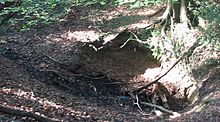Small mine

Small mines were coal mines whose workforce, equipment and production were far below those of a large mine . Most of them were pure tunnel operations (without seigere shafts). Small mines were often given the nickname "Zeche Eimweise", which indicates their small output.
History of the small mines in the Ruhr area
Small mines in the early modern period and in the 19th century
Before industrialization and the associated increased demand for coal , which led to large and technically considerably more complex operations, they were the standard form of hard coal mining.
Even after the closure of large mines, there were often still small mines in the same area. They also made it possible to develop smaller and therefore unprofitable deposits for large mines and were often owned by the miners themselves. In the Ruhr area , small mines could only be operated south of the marl border , as the coal could be found here close to the day. The small mines' trades do not contribute to the Rheinisch-Westphalian coal syndicate founded in 1893 .
Small mines 1945–1976
The mining industry experienced a new heyday in the period of great fuel shortages after the end of the Second World War . At that time, in many places where it was known that coal was once mined, mostly unauthorized digging. Later, the authorities intensified the operation of the small mines, and many companies were now officially registered.
For "small businesses" (as the small mines were officially called) there were special requirements, e. B. with regard to the production quantities (three tons a day, later ten tons in Bochum), the equipment (only “manual work” was allowed), but also the workforce employed (e.g. from pensioners or “mountain invalids” who no longer go to large mines were allowed to work).
The small mines registered in this way had to meet basic requirements. These included the registration of the workers with the miners' union , ventilation of the mine workings , safety of the miners and the deposit of a deposit for the restoration of the surface. So a brisk mining developed with simple inclined shafts, so-called extraction chutes. Depending on the size of the operation, there were complex daytime facilities with barracks, loading facilities and coal bunkers. Some companies even paid for screening plants to prepare the coal, mostly impure lean coal , so that it could be sold.
In many cases, municipalities or paper mills from large parts of Germany also got involved in the Ruhr area to supply themselves with coal.
The historians Matthias Dudde and Stefan Nies document more than 1,000 small mines for the years 1945 to 1970. The regional focus was Bochum in the area of Querenburg , Stiepel and Weitmarer Holz as well as in Dortmund and Witten between Kruckel , Annen and Herbede .
In 1965 the last small mines were shut down due to the shutdown bonus from the Rationalization Association of the Hard Coal Mining . Only a few pits, such as the Glücksstern , Ringeltaube and Egbert collieries , existed for longer. In 1976 this shaft in Buchholz-Kämpen was the last to close.
The only reminder of the many small mines today are often day breaks . The Muttental mining trail provides a historical insight .
Small coal companies in Saarland
In Saarland these pits were called "small coal companies". The Fischbach private mine in the district of the same name in the municipality of Quiigart was the last active small mine in Germany. Hard coal production was stopped there in mid-2008.
literature
- Hans Röhrs: Ibbenbürener Kleinzechen and wild pütts . Ibbenbürener Vereindruckerei (IVD), Ibbenbüren 2009, ISBN 978-3-941607-01-9 .
- Walter Vietor: Kleinzechen in Bochum-Querenburg - a phenomenon after the Second World War. In: Heven then and now . Issue 26, 2011.
- Peter Voss: The mines in the Unna district. Photo chronicle of the mines Freiberg, Caroline, Massener Tiefbau, Alter Hellweg, Königsborn, Monopol, Haus Aden, Prussia, Victoria, Minister Achenbach, Hermann, Werne, Stollen- und Kleinzechen . Regio-Verlag, Werne 1995, ISBN 3-929158-05-1 .
Web links
Individual evidence
- ^ Wilhelm Hermann, Gertrude Hermann: The old collieries on the Ruhr (series: The Blue Books ). Verlag Langewiesche Nachhaben, Königstein im Taunus, 6th, expanded and updated edition. 2008, ISBN 978-3-7845-6994-9 , pp. 37-40.
- ^ Wilhelm Hermann, Gertrude Hermann: The old collieries on the Ruhr (series: The Blue Books ). Verlag Langewiesche Nachhaben, Königstein im Taunus, 6th, expanded and updated edition. 2008, ISBN 978-3-7845-6994-9 , p. 59.
- ^ Mining and mining authorities in Saarland 2008. Annual report of the Oberbergamt des Saarlandes.

